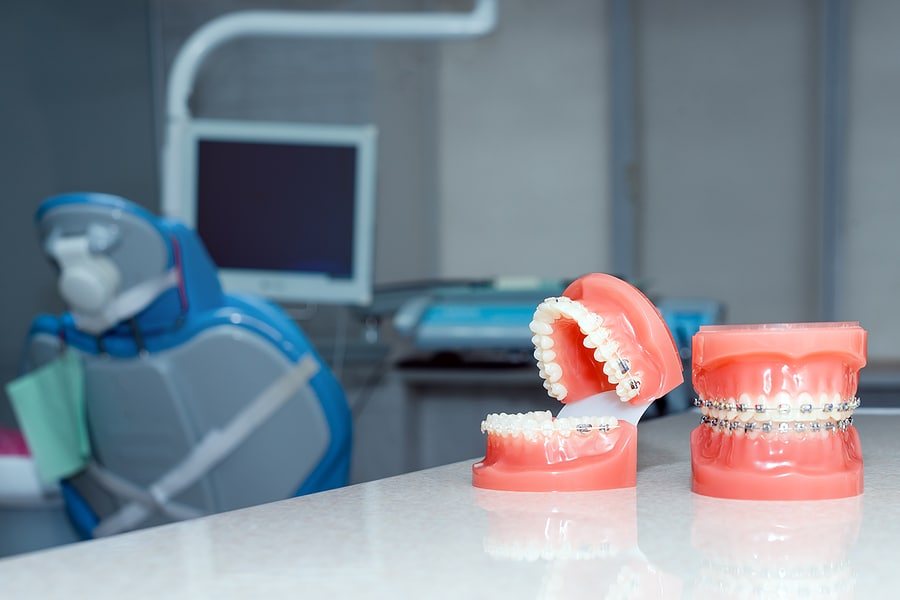Orthodontic treatment has become a common and transformative solution for individuals seeking to achieve a straighter and healthier smile. As dental science continues to advance, the demand for effective orthodontic interventions has led to the development of various types of braces, each with its own set of advantages and considerations. So, how do braces work?
Understanding the Basics of Orthodontic Treatment

Orthodontic intervention is not exclusive to a particular age group. Both adolescents and adults can benefit from braces. During the initial consultation, orthodontists assess individual needs and formulate a personalized treatment plan. Understanding the basics of orthodontic treatment sets the stage for a journey toward a healthier, more confident smile, with braces acting as a reliable tool to bring about positive and lasting changes.
Traditional Metal Braces
Traditional metal braces have stood the test of time as a tried-and-true method for straightening teeth. While advancements in orthodontics have introduced alternative options, the enduring popularity of metal braces attests to their effectiveness in achieving optimal results. These braces consist of a combination of metal brackets, wires, bands, and spacers, working in harmony to guide teeth into their desired positions.
Components of Metal Braces
- Brackets: Metal brackets are affixed to the surface of each tooth. These brackets serve as anchors for the wires and play a crucial role in the overall structure of traditional metal braces.
- Wires: Thin, flexible wires connect the brackets and create the framework for tooth movement. These wires are tightened at regular intervals, applying controlled pressure to initiate and guide the repositioning process.
- Bands and Spacers: Metal bands encircle certain teeth to provide additional support, while spacers create space between teeth to ensure proper alignment during treatment.
Benefits of Traditional Metal Braces
- Cost-Effectiveness: Traditional metal braces are often more budget-friendly than their alternatives, making them accessible to a wider range of individuals seeking orthodontic care.
- Durability: The robustness of metal braces makes them durable throughout the treatment duration, offering reliability and stability in tooth realignment.
- Effectiveness in Complex Cases: Metal braces are particularly effective in addressing severe misalignments and complex orthodontic issues, providing comprehensive solutions for a diverse range of cases.
How Metal Braces Work
- Application of Controlled Force: The fundamental principle of traditional metal braces lies in the application of controlled force. When the orthodontist tightens the wires during periodic adjustments, this force is strategically directed to specific teeth, initiating the process of movement.
- Bone Remodeling: Metal braces work by applying pressure that stimulates a biological response within the surrounding bone tissue. This process, known as bone remodeling, allows the bone to adjust and reshape itself, accommodating the repositioning of the teeth.
- Brackets as Anchors: The metal brackets act as sturdy anchors, providing stability for the wires to exert precise force on each tooth. This ensures that the movement is targeted and controlled, preventing any unwanted shifting.
- Consistent Adjustments: Metal braces work through regular adjustments. During these appointments, the orthodontist fine-tunes the tension in the wires, maintaining the right amount of pressure to guide teeth progressively into their intended positions.
Considerations for Traditional Metal Braces
- Visibility: Noticeable but sleek designs enhance comfort with the visible aspect.
- Cost-Effectiveness: Economical choice, suitable for those with budget constraints.
- Durability: Robust and stable throughout the treatment period.
- Effectiveness in Complex Cases: Excellent for severe misalignments and complex issues.
Clear Ceramic Braces
Clear ceramic braces represent a discreet alternative to traditional metal braces, offering individuals the opportunity to straighten their teeth with a subtler aesthetic impact. These braces share the same fundamental principles as their metal counterparts but employ transparent or tooth-colored materials, making them less conspicuous.
Components of Clear Ceramic Braces
- Brackets: Clear ceramic braces feature brackets made from transparent or tooth-colored materials, blending with the natural color of the teeth. These brackets are affixed to the tooth surfaces to anchor the wires.
- Wires: Similar to metal braces, clear ceramic braces utilize thin, flexible wires to connect the brackets. These wires play a crucial role in applying controlled pressure for tooth movement.
- Bands and Spacers: Clear ceramic braces may also incorporate bands and spacers, but these are often designed to be less noticeable, maintaining the overall discreet appearance.
How Clear Ceramic Braces Work
- Subtle Aesthetics, Same Mechanism: Despite their cosmetic differences, clear ceramic braces work on the same principles as traditional metal braces. The brackets and wires work together to apply controlled force, guiding teeth into their desired positions.
- Application of Controlled Force: The orthodontist adjusts the wires at regular intervals, applying precise pressure to specific teeth. This controlled force initiates the movement process, encouraging the bone to adapt and reshape itself.
- Bone Remodeling: Like metal braces, clear ceramic braces work by stimulating bone remodeling. The pressure exerted on the teeth triggers the bone to change, allowing for the gradual and controlled repositioning of the teeth.
- Visual Discretion: One distinguishing feature of clear ceramic braces is their discreet appearance. The transparency or tooth-colored nature of the brackets makes them less conspicuous, offering a more aesthetically pleasing option for those who may be conscious of the visual impact of orthodontic treatment.
Considerations for Clear Ceramic Braces
- Aesthetics: Discreet appearance but may be slightly visible at close distances.
- Cost: Moderately more expensive, offering a balance between aesthetics and effectiveness.
- Susceptibility to Staining: Brackets may stain; maintaining good oral hygiene is crucial.
- Material Sensitivity: Discuss any potential allergies or sensitivities with your orthodontist.
LightForce Braces
LightForce Braces represent a cutting-edge advancement in orthodontic technology, providing a highly personalized and efficient approach to teeth straightening. Harnessing the power of 3D printing and customized treatment planning, LightForce Braces offers a unique orthodontic experience.
Key Features of LightForce Braces
- Innovative 3D Printing: LightForce braces leverage 3D printing technology to create customized brackets tailored to each tooth’s unique anatomy. This precision ensures optimal efficiency in tooth movement.
- Individualized Treatment Planning: The treatment plan for LightForce Braces is meticulously designed based on a patient’s specific dental needs. This level of customization enhances the accuracy and effectiveness of the orthodontic process.
- Advanced Technology Integration: Integrating state-of-the-art technology, LightForce Braces brings digital precision to the forefront of orthodontic care. This technology streamlines the treatment process for both orthodontists and patients.
How LightForce Braces Work
- Personalized Bracket Design: Each bracket is uniquely designed to fit the contours of an individual tooth, optimizing the surface area for precise force application.
- Customized Treatment Plan: Orthodontists use digital treatment planning to map out the entire course of tooth movement, ensuring that each adjustment aligns with the predetermined plan.
- Efficient Force Application: The customized brackets, combined with the digital treatment plan, allow for efficient and targeted force application, minimizing treatment time and optimizing results.
Advantages of LightForce Braces
- Enhanced Precision: The personalized nature of LightForce Braces ensures unparalleled precision in tooth alignment, reducing the need for extensive adjustments.
- Efficiency in Treatment: The combination of 3D printing and individualized treatment planning accelerates the orthodontic process, leading to potentially shorter treatment durations.
- Improved Patient Experience: With reduced discomfort and fewer adjustments, patients often experience a more comfortable and convenient orthodontic journey.
Possible Disadvantages
- Cost: While effective, LightForce braces may come with a higher price tag. Consider the financial aspects before opting for this technologically advanced option.
- Availability: Check the availability of LightForce braces in your chosen orthodontic practice, as not all clinics may offer this innovative system.
What to Expect During the Braces Journey
A patient’s braces journey involves several key milestones:
Initial Consultation and Assessment
Your orthodontist will conduct a thorough examination, discuss treatment options, and outline a personalized plan based on your dental needs.
Installation Process for Different Types of Braces
Whether opting for traditional metal, clear ceramic, or LightForce braces, the installation process involves fitting the braces to your teeth, setting the foundation for your orthodontic journey.
Regular Adjustments and Maintenance
Periodic appointments for adjustments ensure that the braces exert the right amount of pressure for effective tooth movement. Maintenance checks are crucial for tracking progress.
Potential Discomfort and Tips for Relief
While adjustments may cause temporary discomfort, your orthodontist will provide tips for relief. Over-the-counter pain relievers and orthodontic wax can alleviate minor issues between appointments.
Choose Confidence, Choose Bracesetters Orthodontics
Transform your smile with Bracesetters Orthodontics, the trusted choice in Middletown, Newburgh, Monroe, and Monticello, NY.
 Why Us?
Why Us?
- Recognized as the BEST ORTHODONTISTS in the Hudson Valley, we bring generations of care and a dedication to orthodontic excellence.
- Experience personalized and holistic treatment with our interactive communication style, ensuring your unique needs are met.
- From Incognito appliances to Invisalign®, we offer cutting-edge treatments for all ages.
Ready to transform your smile? Schedule a consultation with Bracesetters Orthodontics today!


 Why Us?
Why Us?